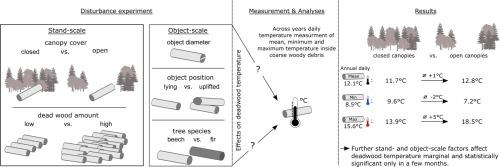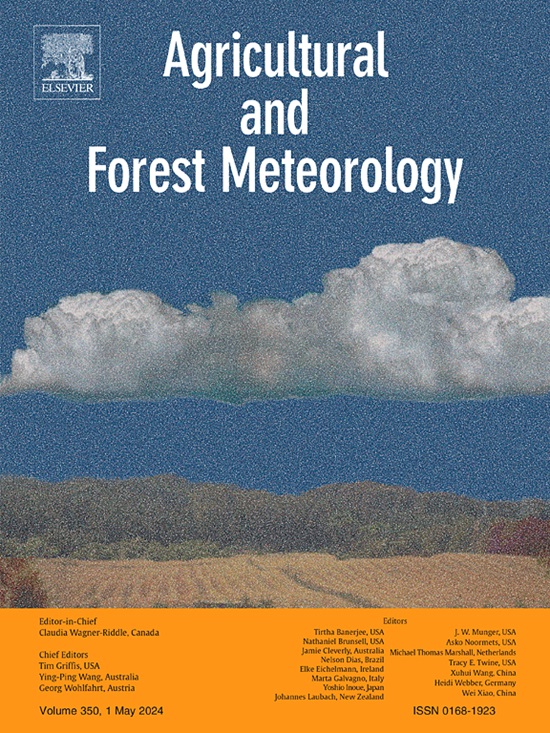冠层介导的小气候和物象特征对枯木温度的影响
IF 5.6
1区 农林科学
Q1 AGRONOMY
引用次数: 0
摘要
枯木是森林生态系统的重要组成部分,支持许多森林栖息物种和生态系统功能,如水和养分循环。温度是过程的主要驱动因素,除其他外,影响朽木内的代谢率。枯木温度是由林分尺度和单个枯木对象尺度上的因子共同决定的。然而,在驱动枯木温度的复杂等级尺度中,个体因素的贡献仍然知之甚少。我们进行了一个真实世界的实验,分析了林分冠层覆盖度(开放vs封闭冠层)、周围枯木量(高vs低)、枯木树种(山毛榉vs冷杉)、位置(土壤接触vs上升)和粗木屑直径(范围:19-47 cm)对枯木内日平均、最低和最高温度在月和季节水平的影响。林分尺度因子比物尺度因子更能解释温度的变化。冠层盖度与温度的关系最强。在生长季节(5 ~ 10月),开放林冠的日平均和最高气温高于封闭林冠,日最低气温低于封闭林冠。此外,在冬季(11月至4月),露天冠层的日最小值较低。与封闭林冠相比,开放林冠的年平均气温和最高气温分别升高约1℃和5℃,最低气温降低约2℃。枯木量、物径、位置和树种对温度的影响在几个月内不太重要,有统计学意义。研究结果表明,冠层覆盖度比枯木特性对枯木内部温度的影响更大。因此,冠层扰动的增加会导致枯枝内温度升高,这可能对枯枝栖息物种和异养呼吸等生态过程产生重要影响。为了使多种物种的栖息地条件多样化,我们建议在不同的冠层条件下丰富枯木。本文章由计算机程序翻译,如有差异,请以英文原文为准。


Effects of canopy-mediated microclimate and object characteristics on deadwood temperature
Deadwood is a crucial component of forest ecosystems, supporting numerous forest-dwelling species and ecosystem functions, such as water and nutrient cycling. Temperature is a major driver of processes, affecting, inter alia, metabolic rates within deadwood. Deadwood temperature is determined by factors at both the forest stand-scale and individual deadwood object-scale. Yet, the contribution of individual factors within the complex hierarchy of scales that drive temperature in deadwood remains poorly understood. We conducted a real-world experiment to analyze the effects of forest stand canopy cover (open vs. closed canopies), surrounding deadwood amount (high vs. low), deadwood tree species (beech vs. fir), position (soil contact vs. uplifted) and diameter (range: 19-47 cm) of coarse woody debris on within-deadwood daily mean, minimum and maximum temperature at monthly and seasonal level. Stand-scale factors were more important than object-scale factors for explaining the variance in temperature. Canopy cover exhibited the strongest relationship with temperature. Daily mean and maximum temperature were higher and daily minimum temperature was lower in open than in closed canopies during the growing season (May-October). Further, daily minimum was lower in open canopies during winter (November-April). Annual daily mean and maximum temperature were about 1 °C and 5 °C warmer, respectively, and minimum temperature about 2 °C colder in open compared to closed canopies. Effects of deadwood amount, object diameter, position, and tree species on temperature were less important and statistically significant in only a few months. We conclude that canopy cover is more important than deadwood characteristics in determining internal deadwood temperature. An increase of canopy disturbance will hence elevate the temperature in deadwood, which might have important consequences on deadwood-dwelling species and ecological processes, such as heterotrophic respiration. To diversify habitat conditions for multiple species, we recommend enriching deadwood under various canopy conditions.
求助全文
通过发布文献求助,成功后即可免费获取论文全文。
去求助
来源期刊
CiteScore
10.30
自引率
9.70%
发文量
415
审稿时长
69 days
期刊介绍:
Agricultural and Forest Meteorology is an international journal for the publication of original articles and reviews on the inter-relationship between meteorology, agriculture, forestry, and natural ecosystems. Emphasis is on basic and applied scientific research relevant to practical problems in the field of plant and soil sciences, ecology and biogeochemistry as affected by weather as well as climate variability and change. Theoretical models should be tested against experimental data. Articles must appeal to an international audience. Special issues devoted to single topics are also published.
Typical topics include canopy micrometeorology (e.g. canopy radiation transfer, turbulence near the ground, evapotranspiration, energy balance, fluxes of trace gases), micrometeorological instrumentation (e.g., sensors for trace gases, flux measurement instruments, radiation measurement techniques), aerobiology (e.g. the dispersion of pollen, spores, insects and pesticides), biometeorology (e.g. the effect of weather and climate on plant distribution, crop yield, water-use efficiency, and plant phenology), forest-fire/weather interactions, and feedbacks from vegetation to weather and the climate system.

 求助内容:
求助内容: 应助结果提醒方式:
应助结果提醒方式:


